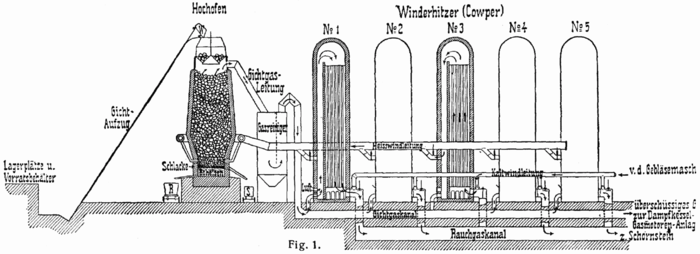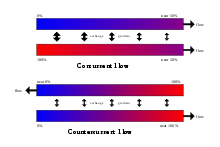- Regenerative heat exchanger
-
A regenerative heat exchanger, or more commonly a regenerator, is a type of heat exchanger where the flow through the heat exchanger is cyclical and periodically changes direction. It is similar to a countercurrent heat exchanger. However, a regenerator mixes the two fluid flows while a countercurrent exchanger maintains them separated. The temperature profile remains at a nearly constant temperature, and this includes the fluid entering and exiting each end.
In regenerative heat exchangers, the fluid on either side of the heat exchanger is nearly always the same fluid. The fluid is cycled through the heat exchanger, often reaching high temperatures. The fluid may go through an external processing step, and then it is flowed back through the heat exchanger in the opposite direction for further processing. Usually the application will use this process cyclically or repetitively. Thus, in regenerative heat exchangers, a fluid incoming to a process is heated using the energy contained in the fluid exiting this process.
The regenerative heat exchanger gives a considerable net savings in energy, since most of the heat energy is reclaimed nearly in a thermodynamically reversible way. This type of heat exchanger can have a thermal efficiency of over 90%, transferring almost all the relative heat energy from one flow direction to the other. Only a small amount of extra heat energy needs to be added at the hot end, and dissipated at the cold end, even to maintain very high or very low temperatures.
Contents
History
The regenerator was invented by Rev. Robert Stirling in 1816, and is commonly found as a component of his Stirling engine. The simplest Stirlings, and most models, use a less efficient but simpler to construct, displacer instead.
Types of regenerators
In rotary regenerators the matrix rotates continuously through two counter-flowing streams of fluid. In this way, the two streams are mostly separated but the seals are generally not perfect. Only one stream flows through each section of the matrix at a time; however, over the course of a rotation, both streams eventually flow through all sections of the matrix in succession. Each portion of the matrix will be nearly isothermal, since the rotation is perpendicular to both the temperature gradient and flow direction, and not through them. The two fluid streams flow counter-current. The fluid temperatures vary across the flow area; however the local stream temperatures are not a function of time.
In a fixed matrix regenerator, a single fluid stream has cyclical, reversible flow; it is said to flow "counter-current". This regenerator may be part of a valveless system, such as a Stirling engine. In another configuration, the fluid is ducted through valves to different matrices in alternate operating periods Ph and Pc resulting in outlet temperatures that vary with time.
Another type of regenerator is called a micro scale regenerative heat exchanger. It has a multilayer grating structure in which each layer is offset from the adjacent layer by half a cell which has an opening along both axes perpendicular to the flow axis. Each layer is a composite structure of two sublayers, one of a high thermal conductivity material and another of a low thermal conductivity material. When a hot fluid flows through the cell, heat from the fluid is transferred to the cell wells, and stored there. When the fluid flow reverses direction, heat is transferred from the cell walls back to the fluid.
A third type of regenerator is called a "Rothemuhle" regenerator. This type has a fixed matrix in a disk shape, and streams of fluid are ducted through rotating hoods. The Rothemuhle regenerator is used as an air preheater in some power generating plants. The thermal design of this regenerator is the same as of other types of regenerators.[citation needed]
Biology
We use our nose and throat as a regenerative heat exchanger when we breathe. The cooler air coming in is warmed, so that it reaches the lungs as warm air. On the way back out, this warmed air deposits much of its heat back onto the sides of the nasal passages, so that these passages are then ready to warm the next batch of air coming in.
Cryogenics
Regenerator heat exchangers are made up of materials with high volumetric heat capacity and low thermal conductivity in the longitudinal (flow) direction. At cryogenic (very low) temperatures around 20 K, the specific heat of metals are low, and so a regenerator must be larger for a given heat load.
Advantages of regenerators
The advantages of a regenerator over a recuperating (counter-flowing) heat exchanger is that it has a much higher surface area for a given volume, which provides a reduced exchanger volume for a given energy density, effectiveness and pressure drop. This makes a regenerator more economical in terms of materials and manufacturing, compared to an equivalent recuperator.
The design of inlet and outlet headers used to distribute hot and cold fluids in the matrix is much simpler in counter flow regenerators than recuperators. The reason behind this is that both streams flow in different sections for a rotary regenerator and one fluid enters and leaves one matrix at a time in a fixed-matrix regenerator. Furthermore flow sectors for hot and cold fluids in rotary regenerators can be designed to optimize pressure drop in the fluids. The matrix surfaces of regenerators also have self-cleaning characteristics, reducing fluid-side fouling and corrosion. Finally properties such as small surface density and counter-flow arrangement of regenerators make it ideal for gas-gas heat exchange applications requiring effectiveness exceeding 85%. The heat transfer coefficient is much lower for gases than for liquids, thus the enormous surface area in a regenerator greatly increases heat transfer.
Disadvantages of regenerators
The major disadvantage of a regenerator is that there is always some mixing of the fluid streams, and they can not be completely separated.[citation needed] There is an unavoidable carryover of a small fraction of one fluid stream into the other. In the rotary regenerator, the carryover fluid is trapped inside the radial seal and in the matrix, and in a fixed-matrix regenerator, the carryover fluid is the fluid that remains in the void volume of the matrix. This small fraction will mix with the other stream in the following half-cycle. Therefore regenerators are only used when it is acceptable for the two fluid streams to be mixed. Mixed flow is common for gas-to-gas heat and/or energy transfer applications, and less common in liquid or phase-changing fluids since fluid contamination is often prohibited with liquid flows.
See also
- Countercurrent exchange
- Economizer
- Heat exchanger
- Hot blast
- Recuperator
- desalination - some thermal desalination plants use regenerative heat exchangers
References
Categories:- Heat exchangers
- Energy recovery
Wikimedia Foundation. 2010.


